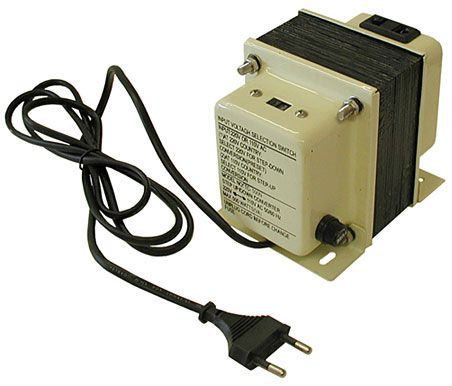Up/Down Transfomer- Electronic Device

A up/down transfomer is an device which can convert mains volage either up or down to a specified voltage.
An example of an up/down transformer is a 120 Vac to 220 Vac or 220 Vac to 120 Vac transformer. This is a transformer that can be used either way. It can convert a voltage from 120 Vac to 220 Vac or from 220 Vac to 120 Vac.
Let's explain now why it's useful that it can convert up or down in a dual fashion.
Suppose you are an American and all the devices you use are meant to be used on American outlets. These are outlets which output 120 Vac. Therefore, most American-owned devices you have run off of 120 Vac mains voltage and converts it. Plugging any item that you have into a European outlet can provide too much power to the device and possibly damage or destroy it, due to excess voltage. If travelling to Europe or many other countries, they operate with a mains voltage of 220 Vac or more. Therefore, you can destroy many of your electrical items if plugging into into European outlets, assuming they fit or you can find the right converter.
This is where the up/down transformer comes into play. If travelling abroad to a country which uses 220 Vac, this transformer can convert this voltage down to 120 Vac, right to the US standard voltage. So you can use all of your products in Europe and other countries when travelling abroad. You won't need to fear the mains power in these other countries may destroy your electrical devices.
In the same way, the dual nature of an up/down transformer can convert 120 Vac to 220 Vac. If you're a European
who normally uses 220 Vac to power your electrical devices and you come to a country such as America which uses a 120 Vac
mains power, you're going to need to convert 120 Vac to 220 Vac, and the transformer can do this. Thus, your
European electrical devices
will work just as normal when using it in the United States as when using it in America.
How an Up/Down Transformer Works
Up/down transformers work by on the principle of energy conversion. They do not increase or decrease power. The total net power is always the same. So even though a step-up transformer increases the voltage output, it decreases current, so that the net output power is the same. Thus, if a step-up transformer doubles the voltage output, the output current is now half of what it was. Thus, if a transformer converts a 100Vac signal that outputs 500ma to a 200 Vac signal, it will not output 250mA. Again, transformers don't create power. They simply convert it from one form to the other.
A step-down transformer works on the same exact principle. Even though it decreases the output voltage, it increases
the output current, so that more current can be output. So if a transformer decreases voltage in half, the current capability
doubles, so that it can give out two times more the current.
Up-down Transformer Power Ratings
Besides the voltage ratings which a transformer converts up or down to, the other major rating for a transformer is its power rating.
Different transformers come with different power ratings.
That same transformer mentioned above which converts either from 120Vac to 220Vac or 220Vac to 120Vac comes in different power ratings- 100W, 200W, or 500W.
Thus, the 500W transformer can output 5 times the power as a 100W transformer. Even though the transformer outputs a fixed voltage, say, 220 Vac, the transformer with a 100W rating can only output approximately 450mA, since power= voltage x current. Since the power is 100W and the voltage is 220Vac, the current that can be output is current= power/voltage= 100W/220Vac. The 500W transformer can output 5 times the current, or approximately 2.27A. Again, current= power/voltage= 500W/220Vac= 2.27A.
Thus, power ratings are important in devices that consume more current. If using a higher power rated transformer,
it has much higher current capibilities than lower rated ones.